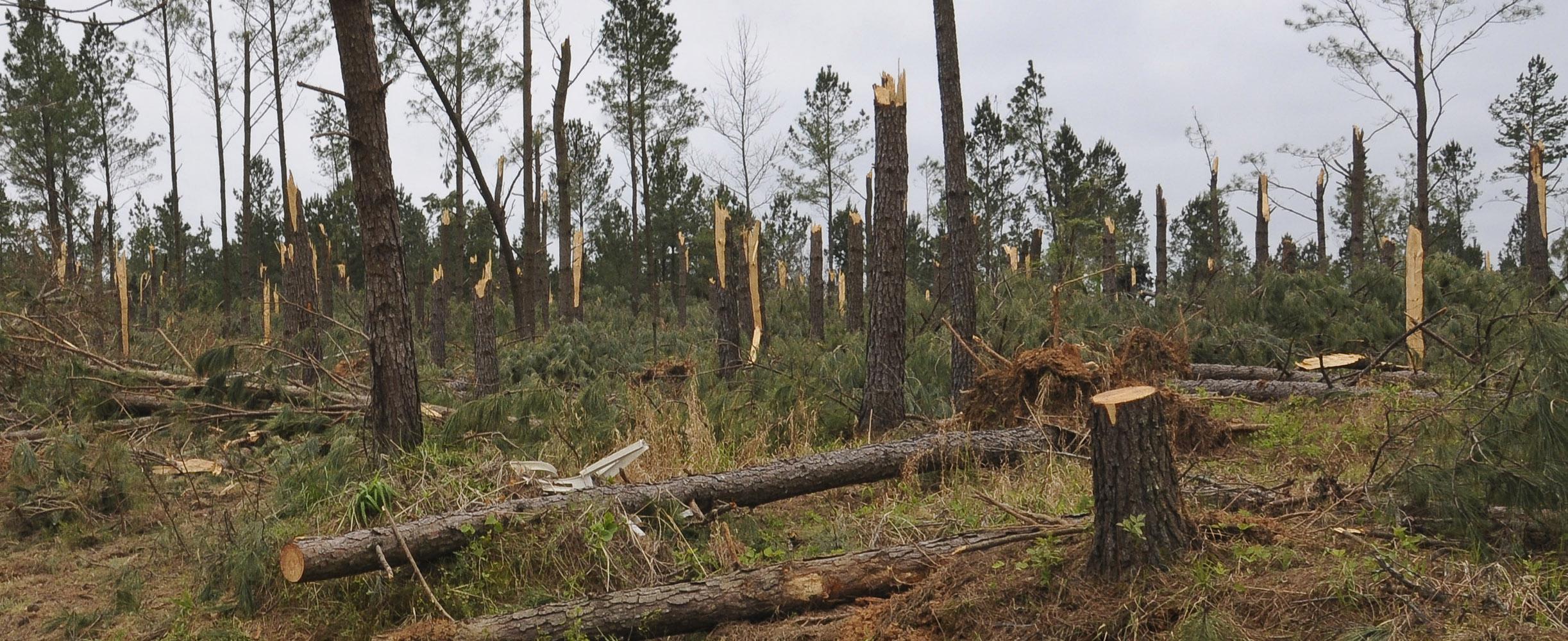Information Possibly Outdated
The information presented on this page was originally released on May 4, 2010. It may not be outdated, but please search our site for more current information. If you plan to quote or reference this information in a publication, please check with the Extension specialist or author before proceeding.
Landowners must act quickly to salvage timber
MISSISSIPPI STATE – Mississippi State University forestry specialists are advising landowners with timber damaged by the April 24 tornadoes to assess and remove injured trees promptly.
More than 62,000 acres of forestland in 10 Mississippi counties sustained damage from the tornadoes. A statewide assessment provided by the Mississippi Forestry Commission reports the value of timber damaged at more than $19 million.
“Trees snapped at the wrong place, splintered or completely downed are of concern to landowners throughout the state,” said Andy Londo, MSU Extension Service forestry professor. “It is important to salvage timber quickly to avoid potential losses.”
Landowners should salvage the highest value stands first, concentrating on pine stands because they are more susceptible than hardwoods to pest outbreaks, Londo said.
“Timber also deteriorates faster during the summer months than in winter,” he said. “Damaged pine sawtimber should be harvested within a few months, before blue stain ruins the wood.”
Pine pulpwood can be harvested within six months. Slightly damaged pines and severely damaged hardwoods may have some value six months to a year following damage. Slightly damaged hardwoods may last for several years, Londo said.
While landowners should act quickly, there are important steps they must follow to have a successful salvage operation. Forestry specialists recommend an initial assessment, followed by removal of damaged trees and an assessment of management strategies for the damaged area, which may include completely starting over for severely damaged stands.
The initial assessment will help landowners determine casualty loss deductions for timber, if applicable.
“Landowners who have a recorded basis, or investment value, in their timber may take a casualty loss deduction, which is the loss in fair market value or the basis in the timber, whichever is less,” said Debbie Gaddis, Extension forestry professor.
Gaddis said the IRS requires owners to salvage timber, if possible. But, before salvage begins, an assessment is necessary to determine the loss in fair market value of the timber.
“Consulting foresters can help landowners provide the initial assessment of loss, possibly determine a retroactive timber basis, and help develop a management plan for the land after salvage of damaged timber,” Gaddis said.
A list of registered foresters is available on the Mississippi Board of Registration for Foresters website at http://www.cfr.msstate.edu/borf. The website allows individuals to search by county and indicates foresters whose primary business is consulting.
The next step is to remove downed and damaged timber.
“Landowners should be aware that the value of their timber will be less than normal because of the damage,” Londo said. “Also, if the timber is not easily accessible, loggers may not be able to pay as much for the timber.”
Look for a trained logger who has completed the requirements for the state’s professional logger program. They have completed training to protect lands from erosion, protect stream quality and protect standing timber. Find them online at http://www.loggered.msstate.edu.
After salvage operations have been completed, landowners should replant or regenerate the area and watch for pest activity and invasive plants.
“Ips beetles, cogongrass and a variety of other pests and invasive plants can move into the damaged area,” Londo said. “Landowners need to replant or regenerate the area of damage, as well as survey the area for these invasives.”
Landowners can find information on storm-damaged timber on the Wind Wood Utilization website at http://www.windwoodutilization.org. The site provides information for landowners, foresters, loggers and others. The site also features a storm blog where visitors may ask questions.






